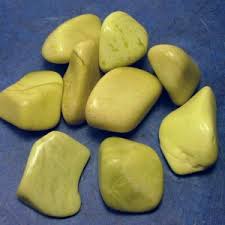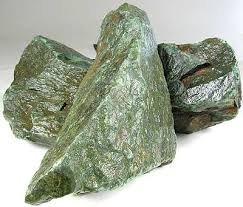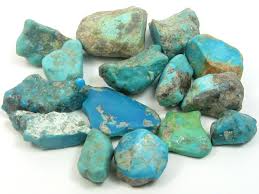Pyrite is most well known by its nickname, fool's gold. Pyrite has been used in many unique ways compared to most other gemstones. It was used as a fire starter in Ancient Roman times, and later became a source of ignition in firearms in the 16th and 17th centuries. Pyrite has been used in the creation of Iron Sulfate and Sulfur Dioxide. It's used in batteries, and in the 20th century was used in radios. Pyrite has a whole genre of jewelry to itself called Marcasite jewelry. This style of jewelry features Pyrite set into silver and was popular during the Victorian era.
Saturday, April 26, 2014
Gem of the Week: Pyrite
Pyrite has been connected to protection and peaceful resistance. It helps the wearer balance the power between themselves and the people around them. Pyrite is a metallic stone usually with a silver or light gold sheen.



Saturday, April 19, 2014
Gem of the Week: Lapis Lazuli
Lapis Lazuli is often connected with higher thinking and activating mental ability. It's also said that Lapis Lazuli helps induce good judgment and wisdom. This makes the stone especially good for business professionals and lawyers. Lapis Lazuli also helps with the healing of the throat and vocal chords. Color: Brilliant Blue sometimes with flecks or stripes of gold.




Lapis Lazuli has been prized throughout history for it's brilliant, bluer-than-blue color. Lapis Lazuli's name comes from a mix of Latin, Arabic, and Persian. The name has inspired words to form in eight languages that relate to the color of the stone. Besides being used for jewelry, decorative weaponry, carving and architecture, Lapis Lazuli has made its name for the intense dye Ultramarine that can only be made by using the pigments of the stone. This dye has been used in paints that the great Renaissance and Baroque painters Masaccio, Perugino, Titian, and Vermeer. The paint would be used in frescoes decorating the walls of basilicas, chapels, and churches. Often, because of the value of the paint, Ultramarine would be used exclusively for the Virgin Mary's clothing as blue was seen as her patron color.

Lapis Lazuli has been prized throughout history for it's brilliant, bluer-than-blue color. Lapis Lazuli's name comes from a mix of Latin, Arabic, and Persian. The name has inspired words to form in eight languages that relate to the color of the stone. Besides being used for jewelry, decorative weaponry, carving and architecture, Lapis Lazuli has made its name for the intense dye Ultramarine that can only be made by using the pigments of the stone. This dye has been used in paints that the great Renaissance and Baroque painters Masaccio, Perugino, Titian, and Vermeer. The paint would be used in frescoes decorating the walls of basilicas, chapels, and churches. Often, because of the value of the paint, Ultramarine would be used exclusively for the Virgin Mary's clothing as blue was seen as her patron color.
Saturday, April 12, 2014
Spring!
The weather's gotten beautiful on Main Street and it's about time too! Summer vacation is just a month and a bit away so don't forget to sign your child up for a camp they'll love! DreamScapes Art Camp is a fun, creative, and tailored experience for each and every student! For more information visit Our Website .
We hope to see you this summer!
We hope to see you this summer!
Gem of the Week: Serpentine
Serpentine is often used in waking up your personal energies and opening your Chakras. This helps your energies flow in a clean natural way. Serpentine also helps heal illnesses of the heart and lungs. Serpentine comes in multiple shades of green and brown usually in a 'scaly' pattern giving it it's name.



Serpentine has been used as a decorative gem for thousands of years. It's name is derived from the Latin for 'serpent rock'. Soil with high concentrations of Serpentine is usually toxic to plant life as the stone has high levels of elemental metals. Generally, Serpentine is more valuable the more pure the color is with less flecks of other colors. Light lime green Serpentine is also rarer than darker shades. In Ancient Rome. Serpentine was used to ward off evil and dark arts as a stone of the goddess Hecate (the goddess of dark magic). It was also said that a Serpentine chalice would shatter if the contents was poisoned.
Saturday, April 5, 2014
Gem of the Week: Turquoise
Turquoise is porous, so contact with liquids, oils or even perspiration should be avoided. Turquoise is considered a good general healer for all illnesses and excellent conductor. Induces wisdom and understanding, enhances trust and kindness. Brings the qualities of mental and spiritual clarity. Color: Light Blue/Blue-green



Turquoise has an extremely long history. It's been used in cultures all over the world for thousands of years. It's been used as a talisman against death, a reminder of heaven, as decoration for kings and priests, and has been used in sacred rituals in ancient cultures. Almost every major culture on earth has had some connection to Turquoise.
The name Turquoise comes from an 16th century french world for "Turkish" because Turquoise first came to Europe through Turkey. Turquoise has been found in mines around the world and some that were started thousands of years ago still produce the gem. Many of these mines are processed by hand using non-mechanical tools.
Turquoise has been found in the excavation sights of Ancient Egypt, Mesopotamia, Persia, Pre-Colombia, the Indus River Valley, and China.
Turquoise was often used in these cultures as a talisman against evil because it can change color under certain conditions (tempurature, acidity, light, dust). Turquoise was also used to decorate important people and buildings. One of the best examples is King Tutankhamen's death mask which is inlaid with Turquoise. Some Iranian palaces are decorated with Turquoise domes as a symbol of heaven on earth.

Turquoise has an extremely long history. It's been used in cultures all over the world for thousands of years. It's been used as a talisman against death, a reminder of heaven, as decoration for kings and priests, and has been used in sacred rituals in ancient cultures. Almost every major culture on earth has had some connection to Turquoise.
The name Turquoise comes from an 16th century french world for "Turkish" because Turquoise first came to Europe through Turkey. Turquoise has been found in mines around the world and some that were started thousands of years ago still produce the gem. Many of these mines are processed by hand using non-mechanical tools.
Turquoise has been found in the excavation sights of Ancient Egypt, Mesopotamia, Persia, Pre-Colombia, the Indus River Valley, and China.
Turquoise was often used in these cultures as a talisman against evil because it can change color under certain conditions (tempurature, acidity, light, dust). Turquoise was also used to decorate important people and buildings. One of the best examples is King Tutankhamen's death mask which is inlaid with Turquoise. Some Iranian palaces are decorated with Turquoise domes as a symbol of heaven on earth.
Subscribe to:
Comments (Atom)